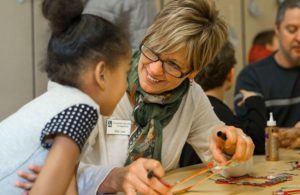Bill Young isn’t new to humanitarian work. He’s been doing it for several decades, including 14 visits to Vietnam and 16 trips to Myanmar (Burma), where he participated in projects on clean water, education, housing, and more. “Those powerful years shaped me into the person I am and the passion I have for service today,” he says.
As executive director of the Alice Virginia and David W. Fletcher Foundation, Young’s passion is now focused on a small neighborhood in Hagerstown, Maryland, called Bester, defined only by a few streets and a railroad. There are no local service resources here; all of its residents must travel a great distance for social services, medical care, infant care, and even a major grocery store. Countywide, Bester has the highest number of children not living with a biological parent. Children can be found living on a neighbor’s couch, raised by a grandmother or an aunt, living in abandoned cars, going hungry.

“What the children of Bester will tell you,” says Young, “is that they want a safe place in which to grow and to play. They don’t want to be out in areas where there is hostile gunfire. They dread going home to parents who are addicted or walking in on a parent who has died from overdose. We knew we could make a difference if we were willing to commit to a long-term reinforcing and rebuilding of this community. This is the heart and the focus of the major project of our foundation.”
In 2014, the foundation committed infrastructure funding for the new Bester Community of Hope, an initiative of San Mar Children’s Home, one of its grantees. In partnership with the Casey Family Programs in Seattle, San Mar aims to safely reduce the number of children placed outside their homes by building “communities of hope.”
“The first thing we did was listen to the community and how it articulates its needs. Then we found a way to build support systems into the existing structure—so instead of the community going out for services, the services are offered right there.” For example, Bester Community of Hope partnered with the Community Free Clinic to provide healthcare to the children who needed care.
“The first thing we did was listen to the community and how it articulates its needs. Then we found a way to build support systems into the existing structure.”
What Young has learned the most over his years of service is this: Each neighborhood has its own culture, and has to be approached with the deepest respect for the individuals who live there. “We created a space where the community identified its own needs, and then we helped to raise up community leaders within those neighborhoods.”
For example, in less than two years, the Bester Community of Hope and its partners have been able to form strategic relationships with various groups in the community—including 16 houses of worship—all committed to a better Bester.
Everyone has to buy into the vision, says Young, and that’s not something that happens overnight. “This is about changing the narrative of an entire community. Consequently the process is slower; it takes a lot of dollars and takes a lot of sweat equity, patience, and deep understanding.”
“This is about changing the narrative of an entire community. It takes a lot of dollars and takes a lot of sweat equity, patience, and deep understanding.”
Yet there are certainly successes along the way. One of the streets in Bester was badly in need of repair. The Bester Community of Hope and its partners used their collective influence to open doors to community leaders and to businesses like Lowes Home Improvement that donated the materials and manpower. Once the houses on the street were repaired, neighbors came together to plan flowerbeds and a community garden.
“These are small steps to build a sense of community, and what it means to be a member of community,” says Young. “Small steps are the only way we are going to fix an otherwise broken system.”

